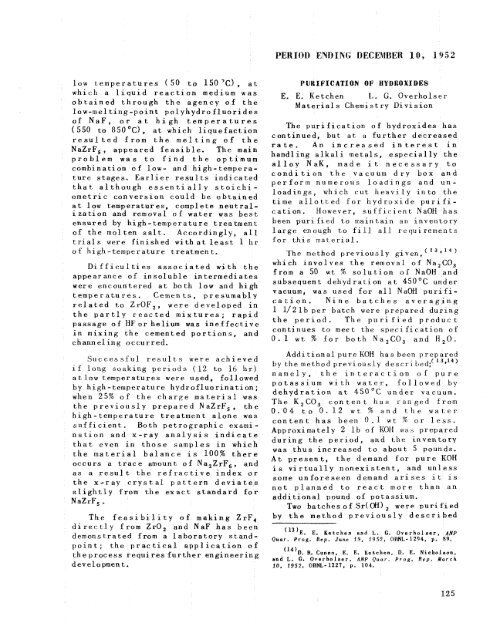the Molten Salt Energy Technologies Web Site
the Molten Salt Energy Technologies Web Site
the Molten Salt Energy Technologies Web Site
You also want an ePaper? Increase the reach of your titles
YUMPU automatically turns print PDFs into web optimized ePapers that Google loves.
PERIOD ENDPRG DECEMBER 10, 1952<br />
low temperatures (50 to 150 'C), at PURIFICATION OF HYDROXIDES<br />
which a liquid reaction medium was<br />
obtained through <strong>the</strong> agency of <strong>the</strong><br />
low-melting-point polyhydrofluorides<br />
of NaF, or at high temperatures<br />
(550 to SSOOC), at which liquefaction<br />
resulted from <strong>the</strong> melting of <strong>the</strong><br />
NaZrFS appeared feasible. The main<br />
problem was to find <strong>the</strong> optimum<br />
combination of low- and high-tempera-<br />
ture stages. Earlier results indicated<br />
that a1 though essen ti ally s t oichi -<br />
ometric conversion could he obtained<br />
at low temperatures, complete neutral-<br />
ization and removal of water was best<br />
ensured by high-temperature treatment<br />
of <strong>the</strong> molten salt. Accordingly, all<br />
trials were finished withat least 1 h r<br />
of high- temperature treatmen t.<br />
Difficulties associated with <strong>the</strong><br />
appearance of insoluble intermediates<br />
were encountered at both low and high<br />
temper a tu res. Cemen ts , p r e sumably<br />
related to ZrOF2, were developed in<br />
<strong>the</strong> partly r~acted mixtures; rapid<br />
passage of HFor helium was ineffective<br />
in mixing <strong>the</strong> cemented portions, and<br />
charin el ing occur red.<br />
Successful results were achieved<br />
if long soaking periods (12 to 16 hr)<br />
at low temperatures were used, followed<br />
by high - temperature hydrofluo rinati on ;<br />
when 25% of <strong>the</strong> charge material was<br />
<strong>the</strong> previously prepared NaZrF,, <strong>the</strong><br />
high- temperature treatment alone was<br />
sufficient. Both petrographic exami-<br />
nation and x-ray analysis indicate<br />
that even in those samples in which<br />
<strong>the</strong> material balance is 100% <strong>the</strong>re<br />
occurs a trace amount of Na2ZrF6, and<br />
as a result <strong>the</strong> refractive index or<br />
<strong>the</strong> x-ray crystal pattern deviates<br />
slightly from <strong>the</strong> exact standard for<br />
NaZrF,.<br />
E. E. Ketchen L. G. Overholser<br />
Materials Chemistry Division<br />
The purification of hydroxides has<br />
continued, but at a fur<strong>the</strong>r decreased<br />
rate. An increased interest in<br />
handling alkali metals, especially <strong>the</strong><br />
alloy NaK, made it necessary to<br />
condition <strong>the</strong> vacuum dry box and<br />
perform numerous loadings and un-<br />
loadings, which cut heavily into <strong>the</strong><br />
time allotted for hydroxide purifi-<br />
cation. However, sufficient NaQH has<br />
been puri fled to maintain an inventory<br />
large enough to fill all requirements<br />
for this material.<br />
'I'he method previously<br />
which involves <strong>the</strong> removal of Na2C0,<br />
from a 50 wt % solution of NaOH and<br />
subsequent dehydration at 45OOC under<br />
vacuum, was used for all NaOH purifi-<br />
cation. Nine batches averaging<br />
1 1/2lh Der batch were prepared during<br />
<strong>the</strong> period. The purified product<br />
continues to mee t <strong>the</strong> specification of<br />
0. 1 w t 7% for both Na2C0, and H,O.<br />
Additional pure KOH has been prepared<br />
by <strong>the</strong> method previously desc~ 1 hed;' l3,I4)<br />
namely, <strong>the</strong> interaction of pure<br />
potassium with water, followed by<br />
dehydration at 45Q'C under vacuum.<br />
The K2C0, content has ranged from<br />
0.04 to 0. 12 w t % and <strong>the</strong> water<br />
content has been 0,l w t % or less,<br />
Approximately 2 lb of KOH wab prepared<br />
during <strong>the</strong> period, and <strong>the</strong> inventory<br />
was thus increased to about 5 pounds.<br />
A t present, <strong>the</strong> demand for pure KOH<br />
is virtually nonexistent, and unless<br />
some unforeseen demand arises it is<br />
not planned to react more than an<br />
additional pound of potassium.<br />
Two batches of Sr(OH), were purified<br />
The feasibility of making Z~F, by <strong>the</strong> method previously described<br />
directly from ZrOz and NaF has been<br />
(13)E. E. Ketchen and L. G. Overholser, ANP<br />
demonstrated from a laboratory stand- Quar. Prog. Rep. June 19, 1952, OWL-1294, p. 89.<br />
point; <strong>the</strong> practical application of<br />
<strong>the</strong>Process requires fur<strong>the</strong>r engineering<br />
(I4)D. R. Cuneo, E. E. Ketchen, D. E. Nicholson,<br />
and L. C, Overholser, AN^ Qua.. prog. Repa March<br />
d ev e 1 o pmen t . 10. 1952, ORNL-1227. p. 104.<br />
125



![Review of Molten Salt Reactor Physics Calculations [Disc 2]](https://img.yumpu.com/21979492/1/190x247/review-of-molten-salt-reactor-physics-calculations-disc-2.jpg?quality=85)












